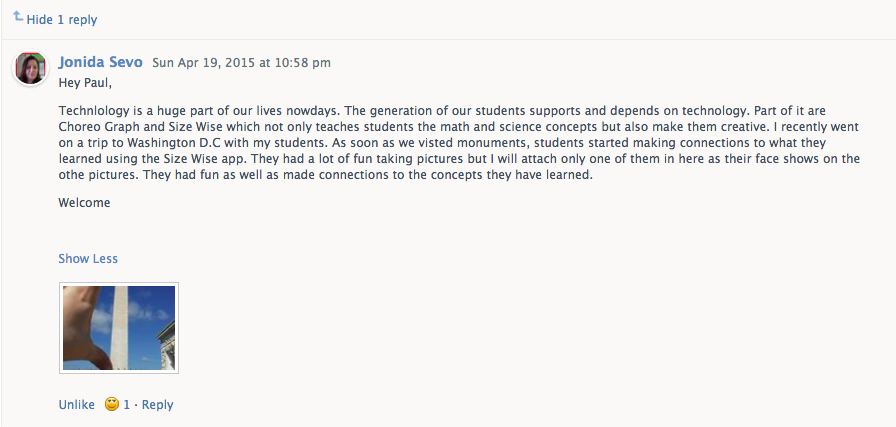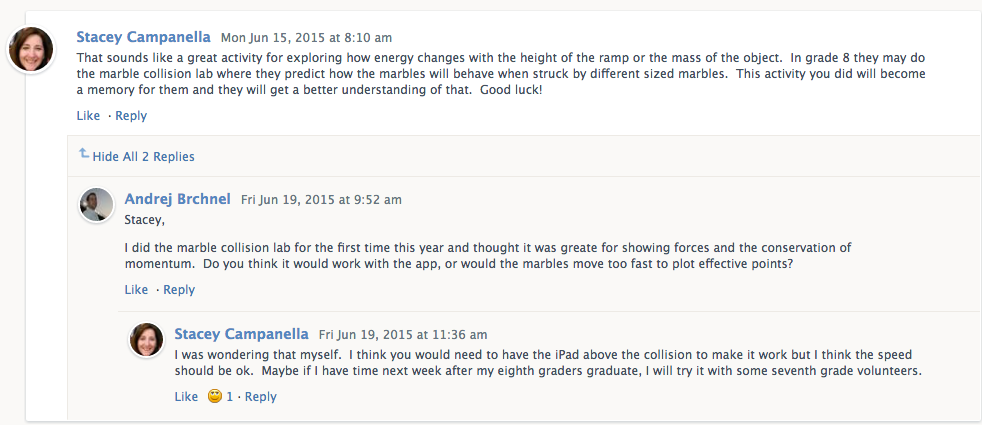Feature
Noticing by NYSCI
Formal and Informal Educators Partnering for Professional and Student Growth
Connected Science Learning November 2016-January 2017 (Volume 1, Issue 2)
By Amanda Solarsh, Gina Tesoriero, Michaela Labriole, and Tara Chudoba
Noticing by NYSCI is a project based at the New York Hall of Science that fosters deeper student learning and engagement through the use of five specialized, iPad-based mobile apps. Throughout the process of developing these Noticing Tools, a cohort of classroom educators helped NYSCI staff design the initial concepts, test the apps, create curriculum, and ultimately shape and facilitate online professional development modules for other educators.
As a leader in the science museum field, the New York Hall of Science (NYSCI) is a destination for hands-on, interactive exhibitions and innovative programs. NYSCI’s Design-Make-Play (DMP) pedagogical approach to STEM learning recognizes that what is essential is not only the content—what is being taught—but how teaching and learning are imagined through the curriculum. This commitment to practice builds off of interest-based learning research, which emphasizes that all learners should feel a sense of efficacy and possibility. The hallmarks of this approach include deep personal engagement, personal choice, iterative design practices, and improvements on existing work (Honey and Kanter 2013). DMP is grounded in five core principles:
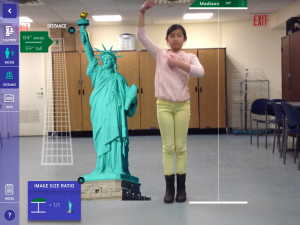
- People and play at the center. NYSCI leverages children’s natural instincts to engage playfully with things they find compelling and enables them to become part of the data under investigation.
- Kids as creators. We engage kids as creators and makers, not just consumers, of content, materials, and material objects.
- Problems you think are worth solving. We support interest-driven problem solving, in which learners actively shape the tasks they are working on.
- Divergent solutions. Students are encouraged to pursue problems that have no one right answer.
- Open invitation. Our activities present a low barrier to entry, a high ceiling of rich potential complexity, and a wide berth for the creative expression of ideas.
This approach, which is used to tackle concepts that are often the most difficult or abstract for students to master and where they often lose their enthusiasm for STEM, has guided the development of the Noticing by NYSCI initiative.
Noticing by NYSCI was developed to foster deeper learning and deeper engagement through DMP, using a suite of five specialized, iPad-based mobile apps called Noticing Tools.
The five Noticing Tools in the suite are:
- Fraction Mash: Enables students to explore fractions while creating entertaining photo mashups, such as swapping parts of their friend’s face with a cat’s or mixing their teacher’s face with a favorite celebrity. During the course of their play, students get to manipulate the size and number of the pieces that appear in their final creations and fluidly experience how fractions can be represented in many ways.
- Choreo Graph: Invites students to explore graphs and coordinate geometry as they choreograph funny dance moves of animated characters they create. The app uses photos as the raw material for students’ animations, enabling them to reason about mathematical concepts such as complementary and supplementary angles, symmetry, and translations.
- Size Wise: Allows students to explore ratios and proportions while they create funny pictures that make things look wildly bigger and smaller than they really are. The app uses forced perspective photography to invite young people to reason proportionally.
- Volumize: Empowers students to take two-dimensional photos of things they see and make the photos three-dimensional. While building their 3-D renditions, students explore the relationships between surface area and volume.
- Playground Physics: Allows students to discover and explore the physics in their everyday life and their own movements. They can record a video of friends—or anything in motion—and tap points along the way to trace a path to discover the motion, forces, and energy involved.
At the center of the experience, students use the world as their laboratory to make meaningful science and mathematics discoveries while designing solutions to problems they find worth solving. NYSCI’s innovative tools turn math and science instruction on its head and allow for many degrees of freedom when it comes to implementation. Although an informal setting allows for the flexibility to develop innovative STEM approaches and resources, it is because of dedicated partnerships with classroom teachers that NYSCI’s mission-based projects have deep and meaningful national and international reach. To align with curricula across different grade levels and to support a wide variety of learners, NYSCI knew it would be critical to use its existing relationships with classroom teachers to ensure that the Noticing Tools would be relevant and compelling to support teaching and learning in a formal setting. By engaging teachers as codesigners and codevelopers, NYSCI was able to design strategies and supports that are responsive to teachers’ and learners’ needs.
As a teacher, I really struggle in terms of planning activities in the classroom that are creative, involving technology that would really tickle students’ interests. What I like about the Noticing Tools—Choreo Graph to be more specific—is that aside from it addressing my concern about creative technology activities, it also allows students to produce multiple outputs that are entirely different from each other without much effort differentiating my lesson. By exploring the tools, a beginner student may create [a] few simple moves to produce a story, while an advanced student may utilize several complicated moves to convey his/her ideas. Though the two produce entirely different outputs, both still satisfy the same learning outcome that I want them to master. —NYSCI Master Teacher
Noticing Tools(TM) by NYSCI from NYSCI on Vimeo.
The Start of a Partnership
NYSCI has consciously built relationships with teachers through projects and initiatives. One example of this is NYSCI’s work with two local middle school teachers, Gina Tesoriero and Amanda Solarsh. NYSCI’s partnership with Tesoriero and Solarsh goes back to 2009, when the pair attended their first NYSCI professional development (PD) program. Intrigued by the content and practices they were learning, Tesoriero and Solarsh continued returning to NYSCI for professional development and implemented what they learned in their own classrooms.
I watched my students complete (design) projects that I didn’t think were possible. These opportunities offered my most struggling learners time to shine. I watched my 12:1:1 group of all boys grow to be serious about their academics and persevere when given a challenge. One student in particular had a very hard time learning and he was able to became a leader in the design classroom. —Gina Tesoriero, NYSCI Master Teacher
By giving teachers alternative ways to get to the core of what they teach, including open-ended prompts and projects that allow for divergent solutions, NYSCI’s approach allowed Tesoriero and Solarsh to notice new things about their students and called into consciousness how their students learn. The relationships built during these PD workshops established a mutual respect and understanding between the teachers and NYSCI’s staff, bridging the formal and informal worlds of teaching and learning.
As the relationship between the teachers and NYSCI’s informal educators grew, new opportunities to partner developed organically. Tesoriero and Solarsh were early participants in NYSCI’s Verizon Foundation Design Lab Teacher Fellows Program. Through this fellowship, Tesoriero and Solarsh worked alongside NYSCI educators to co-create classroom resources that reflect a design-based approach to classroom teaching. It was during this time that the relationship between the informal and formal educators grew beyond a traditional PD provider model into a deeper partnership. NYSCI afforded the formal educators time and space to collaborate with their peers and move out of their comfort zone to embrace the design process—an iterative practice of improving from failure. In turn, NYSCI educators were invited into Tesoriero and Solarsh’s classrooms, providing an opportunity for the informal educators to improve their own practices and refine the resources they were able to provide to other educators. This work ultimately resulted in Tesoriero and Solarsh creating a new engineering design curriculum for their sixth through eighth graders.
Takeaway: Partnerships can evolve organically over time if both informal and formal educators are given opportunities to work together in new ways.
Master Teachers
As a logical extension of this past work, and with funding from the Verizon Foundation, NYSCI created the Noticing by NYSCI Master Teacher program, which ran from 2014 to 2016 and included Tesoriero, Solarsh, and several other middle and high school classroom educators. Throughout the process of creating the Noticing Tools, the Master Teachers played a key role—from designing the initial concept, testing the apps, and creating curricula, to ultimately shaping and facilitating online PD modules that provide support to teachers experiencing NYSCI’s apps and resources for the first time.
NYSCI’s Master Teachers committed to participating in the program for one academic year, with the option to continue for an additional year. They met quarterly throughout the year, but also participated in an online community of practice where they responded to NYSCI-generated prompts and engaged in their own conversations. The agenda below reflects a typical face-to-face meeting, featuring a two-way stream of feedback and collaboration to develop the online PD modules.
Participants also regularly updated Master Teacher Feedback Forms, on which they recorded their experiences using the tools in the classroom. The form included the following:
- What activity did you implement? If this is a new activity you created, please describe.
- Describe any changes you made to the existing activity.
- How would you do things differently next time?
- What successes did you encounter? Why do you think that is?
- How did the tools affect dynamics in the classroom?
- What role did you play in the classroom? Were you observing? Leading a demonstration?
- How did you document student work? The process? The end product? Provide evidence.
- What type of learning did you observe?
In addition to receiving a stipend and the title Master Teacher, participants benefited from early access to the Noticing Tools and classroom coaching and support from NYSCI staff. NYSCI conducted focus groups and content analysis of online discussions, and asked Master Teachers to fill out feedback forms at various points throughout the year to gather data about their experiences.
As the first Master Teacher cohort began to integrate the tools into their classrooms, interesting themes started to emerge in the focus groups and online forums. For example, because the Noticing Tools allow students to be creators and invite them to identify the problems they are trying to solve, many teachers noticed that students were using more mathematical discourse and that the tools were engaging students who previously had limited classroom participation in mathematical problem solving. This type of student thinking is often difficult for teachers to see and therefore hard to assess. By working together, Master Teachers and NYSCI staff were able to articulate the type of powerful learning facilitated by the Noticing Tools and the DMP approach and apply them to creating resources and supports for other educators. Because this approach to learning—and the use of technology to support this type of deep thinking—was new to the teachers we worked with, clear communication was vital to building a shared understanding. NYSCI staff often asked probing questions to get a clear view of what was happening in the classroom, and classroom educators helped NYSCI identify areas where learning theory connected with teaching practice. In the process of building the tools, the NYSCI team was purposeful about creating tools that would allow students to apply mathematical thinking in meaningful ways. It was not until discussions with the Master Teachers, however, that it became apparent the extent to which the tools gave students the context for really applying what they had been learning. One teacher shared that she had been focusing on a complex math topic for several weeks but was not sure what students were internalizing. Upon presenting students with one of the Noticing Tools, they immediately began creating content-rich projects and she noted, “[students] needed little help seeing the math.”
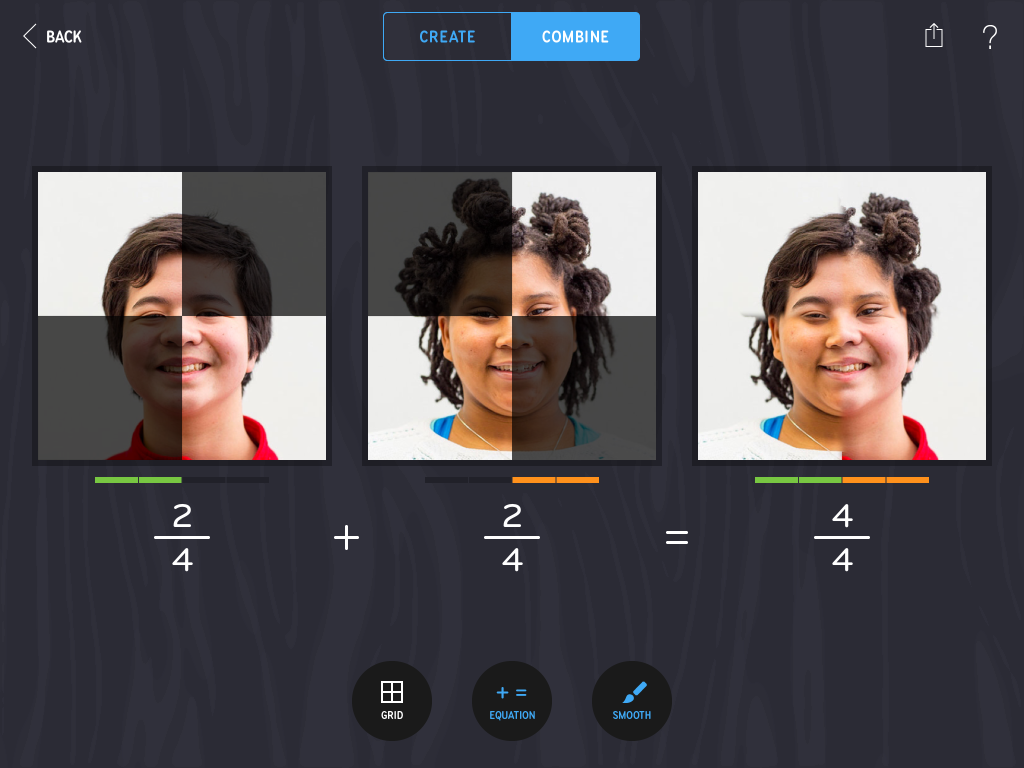
The Master Teachers were able to parlay these experiences into the co-creation of online PD modules for other teachers. Master Teachers were integral to these online PD modules, because they had played a significant role in the app-development process and they were cognizant of the obstacles that teachers face with curriculum and time constraints. Each module focused on a different tool and was designed to take four weeks (10 hours total) to complete. All of the work was asynchronous, with module participants working at their own pace to complete interactive projects, participate in discussion forums, and reflect on how the Noticing Tools can be integrated into the classroom. For example, the outline for the Fraction Mash module included the following:
Week 1
- “Getting to Know You” Discussion Forum
- Fraction Mash Overview Reading
- Try It: Create a mash-up using Fraction Mash
- Cool Contexts: Share examples of mash-ups in everyday life
Week 2
- Scenes from the Classroom: Master Teacher classroom vignette
- Try a Fraction Mash activity in your classroom
- Use the Discussion Forum Prompts to Reflect on Your Experience
- Share an Example of Student Work Produced Using Fraction Mash
Week 3
- Explore Fraction Mash Reflection Tool
- Scenes from the Classroom: Master Teacher classroom vignette
- Reflect on Student Work Example Using Guided Reflection Questions
- Assessment Strategies Reading and Reflection
- Wrap-Up Discussion Forum
Prior to the modules, the Master Teachers worked with NYSCI staff to identify the content and resources they felt other teachers would need to learn how to use the tools meaningfully. They also helped generate classroom vignettes that allowed other teachers a glimpse into real classrooms to highlight the various ways in which the tools can be used.
gina-scenes-from-the-classroom
During the modules, Master Teachers shared their classroom use scenarios, prompted discussions, and provided ideas for assessment. They hosted unique conversations, offering up their experiences, realistic classroom management techniques for using technology in the classroom, and advice for teachers with questions or concerns.
This authentic “teacher voice” was a crucial component of the program that only classroom educators could bring to the table. The value of this authenticity emerged as a key theme in the evaluation of the PD modules and in postcourse surveys: 83% of participants indicated that Master Teachers were the most valuable aspect of the course.
These were ideas from actual teachers that have tried these concepts. The discussions helped to make clear what they meant and their process for getting their objectives accomplished. This helped me to understand how I can implement this in my own classroom. —PD Program Participant
Takeaway: As informal institutions push the boundaries of innovative learning resources, it is key that they partner with formal educators in new ways and at different stages of resource development to ensure usability and authenticity.
Degrees of Freedom Versus Understanding of Constraints
Professional learning capacity for both NYSCI educators and classroom teachers was dramatically increased through the Master Teacher program. In committing to each other’s growth, both parties gained opportunities to expand well beyond what they could have accomplished individually. For example, classroom teachers would not have had the opportunity to access ongoing support in using a new digital tool in the classroom, whereas NYSCI staff would not have had access to such varied classroom-use scenarios. A surprise for the informal educators was how much classroom teachers valued the opportunity and support to step outside of their comfort zone and try new tools and strategies in the classroom.
As teachers, we are continually looking for ways to improve our teaching practices and to make our classrooms more engaging for students; however, we do not always have the time and resources to try new ideas. There is also the fear of trying the unknown and the uncertainty of how a new lesson or activity is going to be received by the students. Having the support from NYSCI made us feel more confident to step outside of our comfort zone, which we would never … have been able to do without our partnership. —Gina Tesoriero, NYSCI Master Teacher
The informal educators were able to provide the classroom teachers with degrees of freedom needed to expand their practice, whereas the classroom educators helped the NYSCI team gain a deeper understanding of the constraints faced by formal educators. This allowed NYSCI to generate more useful classroom activities, identify new classroom management strategies, and provide stronger professional development resources around the Noticing Tools. Similarly, teachers were able to give NYSCI deep insight into how the tools supported different types of learners, including different populations of students. For example, the classroom teachers shared that because the tools motivated students to use more mathematical language in describing their projects, the tools were valuable in building language skills for English language learners. This type of insight was critical to the innovative approach to learning for which NYSCI was striving.
Takeaway: The flexibility and support provided by informal institutions can allow formal educators opportunities to step outside of their comfort zone and expand their practice. Similarly, formal educators’ practical experience helps informal educators develop materials and resources that work within the boundaries of the classroom.
Students as Codesigners
Additionally, teachers were able to see how their feedback, and the feedback of their students, directly contributed to the refinement of the apps and the supporting classroom materials. Throughout the development period, the NYSCI team conducted formative research and tested several iterations of the tools with teachers and students in the museum and in classrooms. Using evidence from structured observations, focus groups, interviews, open-ended essays, and pre-post questionnaires, the focus of this research was to test the usability, comprehensibility, and appeal of the Noticing Tools and their related functionalities and curricular activities. More specifically, we were looking to understand how students made sense of different features of the app as we were conceiving of them, as well as the mathematics that they noticed and understood in the process. We were also interested in teachers’ perceptions of the usefulness of the apps to their teaching and the learning they supported. In addition to gathering user data, the app developers shared with students how their feedback would be used to create an app that would be shared with classrooms around the world.
This research revealed that this process was a powerful way for students to see themselves as “experts,” feel valued and listened to, and be a part of the development process. Both teachers and informal educators were often astounded at the level of students’ engagement, afforded not only by the tools themselves but by being key contributors to the app design process.
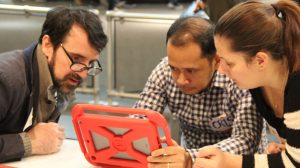
Students became extremely invested in the tools, repeatedly asking their teachers for updates on how their ideas were being integrated into the creation of the apps and resources. This deep investment helped both the teachers and NYSCI educators learn the importance of actually following up on the feedback provided by students. Because students were specifically asked to provide feedback on aspects of the project still in development, there were opportunities to use their input in meaningful ways that were obvious to everyone. For example, students were so eager to share their creations with their friends that NYSCI built in additional sharing features to make it easier for students to “Instagram their homework.” The teachers felt that this was a priceless opportunity for their students and one that would not have been possible without their strong partnership with an informal institution.
Takeaway: Partnerships between informal and formal learning institutions can include educators and students, but it is critical that the input provided by all partners is actionable. Partners need to see that their expertise and input are valuable and used.
Reflections
The success of this partnership is a result of both parties recognizing the different skills and ideas they could bring to the collaboration and how they could both benefit from working together. It is also the result of recognizing the boundaries of such a partnership. Any partnership brings challenges, and it took time for partners to navigate each other’s constraints. For example, early on, there was a disconnect between the project time line and the teachers’ availability to test materials or facilitate online modules. As soon as this became apparent, partners worked together to craft a schedule that was more realistic. Similarly, methods of communication and collaboration were streamlined and defined over the course of working together. At the outset of the project, goals and milestones were established, but the partnership remained flexible enough to shift as data from the classroom began to come in. For example, as focus groups began to indicate that increased mathematical discourse was a strong benefit of using the Noticing Tools, we were able to shift some of the work to explore this topic more deeply.
The project’s emphasis on bringing DMP to the classroom was another key component in the success of the partnership. The Master Teachers came from more traditional teaching settings, not necessarily progressive or well-resourced schools, and the student-centered approach afforded by the tools was novel to some of the educators. Although introducing novel teaching practices can be challenging, the unique approach required the informal and formal educators to rely more heavily on one another, which lead to a much richer collaboration. NYSCI staff learned how to use the experience and knowledge of teachers to take what they had developed in an informal education institution and apply it successfully to a variety of formal educational settings. At the same time, as the teachers began to notice deeper student engagement with content, they turned to NYSCI staff for additional support and further resources. This shared commitment to student-centered learning fostered a lasting relationship that was able to withstand the challenges inherent in most partnerships.
Moving Forward
The Master Teachers helped identify specific contexts in which the tools were particularly useful, which helped shape the direction of new work. For example, feedback from the teachers indicated that the tools can be especially valuable for supporting specific populations of students, including English language learners and students on the autism spectrum. According to teachers, in addition to motivating the use of mathematical language, the tools increased students’ persistence in completing a task, allowed for more easily differentiated instruction, and provided opportunities to more deeply assess student thinking for students who do not do well on more traditional assessments. Next phases of the project will include creating resources for these students, as well as continuing to develop more general resources and content. The Master Teacher cohort remains a valuable part of this future work.
Although this partnership took several years to fully emerge, it has been maintained by both parties, who view each other as equal partners and valuable resources that help further grow and expand their respective practices. Through trust and communication, this type of partnership can certainly be sustainable. NYSCI has recognized the value in collaborating with teachers and has made this type of collaboration a priority in furthering its institutional mission. NYSCI is determined to not just deliver a service of professional development but also use the expertise of teachers to inform their work, contributing to ongoing development and resources that are responsive to learners’ needs. In return, NYSCI is helping teachers grow as learners and informing their practice.
Amanda Solarsh (asolarsh@schools.nyc.gov) is a STEM teacher at MS-104 Simon Baruch Middle School in New York, New York. Gina Tesoriero (gtesoriero@schools.nyc.gov) is a STEM teacher and special education learning specialist at MS-319 Maria Teresa Mirabal Middle School in New York, New York. Michaela Labriole (mlabriole@nysci.org) is manager of special projects at the New York Hall of Science in Corona, New York. Tara Chudoba (tchudoba@nysci.org) is an exhibit and activity developer at the New York Hall of Science in Corona, New York.
Middle School Informal Education



